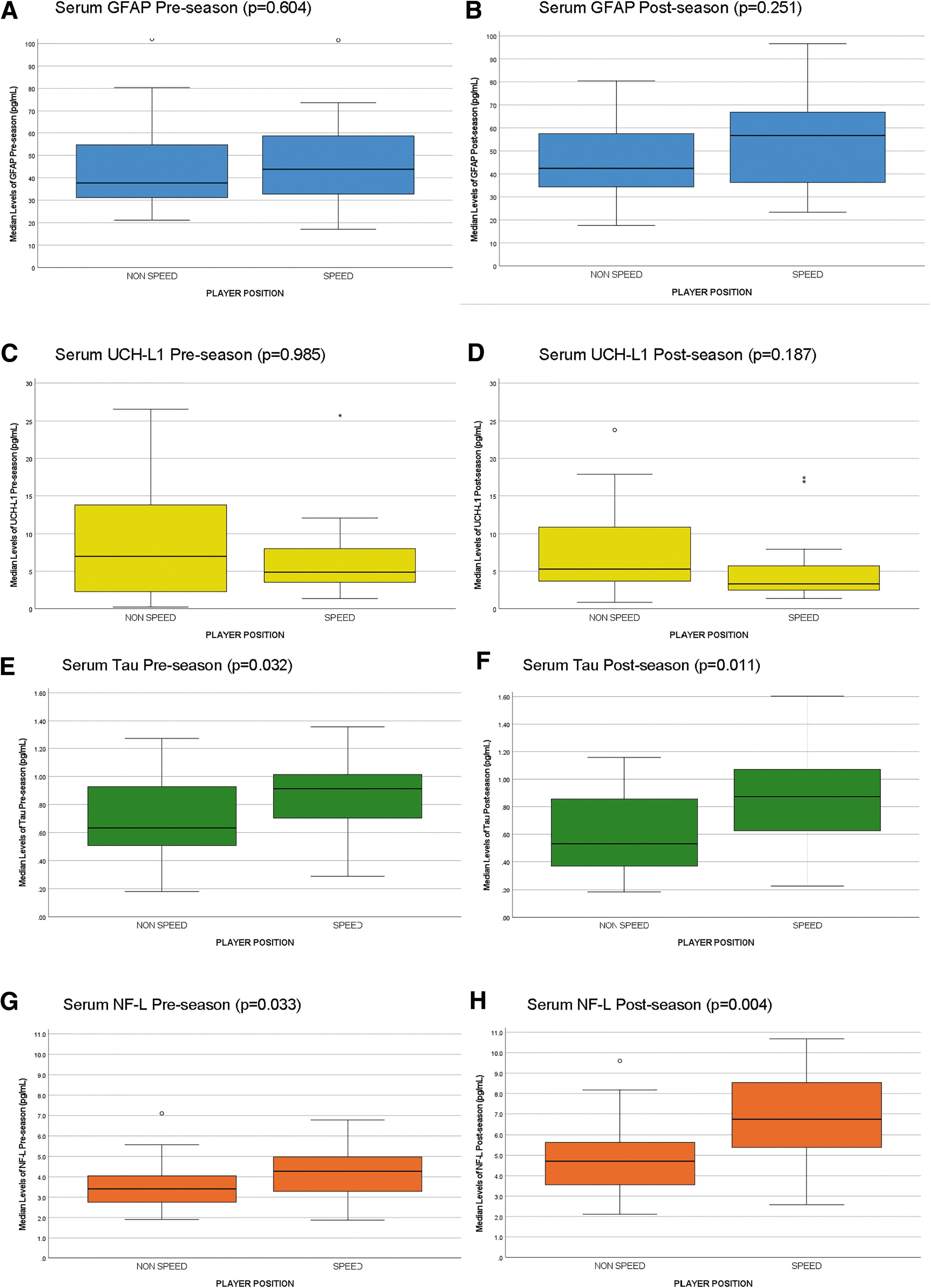Box plot comparison of mean serum levels of four protein biomarkers [GFAP]ubiquitin C-terminal hydrolase-L1 [UCH-L1]total tau and neurofilament light chain polypeptide [NF-L]) by the position of the player’s speed. Box plots represent medians with interquartile ranges. (A) Preseason serum GFAP concentrations in non-speed and speed positions; (B) Postseason serum GFAP concentration in non-speed versus speed positions; (C) Preseason serum UCH-L1 concentrations in non-speed versus speed positions; (D) Postseason serum UCH-L1 concentration in non-speed versus speed positions; (E) Preseason serum tau concentrations at non-speed and speed positions; (F) Postseason serum tau concentrations at non-speed and speed positions; (G) Preseason NF-L serum concentrations in nonspeed versus speed positions; (H) Postseason serum NF-L concentrations in nonspeed vs. speed positions. credit: Journal of Neurotrauma (2022). DOI: 10.1089/neu.2022.0083
A new research study looks into the brains of college football athletes to measure levels of traumatic brain injury (TBI) biomarkers by player position. This study, conducted in collaboration with researchers at Orlando Regional Medical Center (ORMC) and The Pennsylvania State University, is published in Journal of Neurotrauma, sheds light on which positions are at greatest risk for elevated brain injury biomarkers. Biomarkers are proteins and other substances that are released from the brain after it is damaged.
Researchers followed 52 college football athletes before and after the season and measured four biomarkers (glial fibrillary acidic protein [GFAP]ubiquitin C-terminal hydrolase-L1 [UCH-L1]total tau and neurofilament light chain polypeptide [NF-L]). Players were grouped into two established classification systems: Speed vs. Speed Positions and Profile 1, Profile 2 and Profile 3.
“We found that the biomarkers were much higher football players at speed positions such as quarterbacks, wide receivers, defensive backs, running backs, linebackers, fullbacks, tight ends, defensive backs, safeties, and linebackers, who gain momentum before making the catch or being tackled, compared to non-speed positions, such as the offensive and defensive lines, that involve other players before significant momentum can be gained,” said Linda Pope, MD, lead study author and emergency physician and director of Academic Clinical Research at Orlando Health ORMC.
“It’s interesting that biomarkers increased at all positions during the season, despite very few players being diagnosed with concussions. This suggests that repeated head impacts increase biomarkers of TBI without concussion.”
In addition, Pope and his colleagues used a three-level player position classification system developed by the researchers using biomechanical measurements, including the amount of header deformation, header frequency and intervals. Profile 1 positions are those that receive high intensity but infrequent shocks (researchers refer to this as high strain/low frequency).
These positions include running backs, wide receivers and defensive backs. Profile 2 positions are the average snap rate and strain positions, including linebackers, running backs, and tight ends. Profile 3 positions are those that are hit frequently but are hit at a lower intensity (low magnitude/high frequency) and include defensive linemen and offensive linemen.
“It appears that the greatest increase in TBI biomarkers is not the frequency but the magnitude of head impact,” said Dr. Pope. “We found a gradual increase in the biomarkers GFAP, Tau and NF-L as a function of player position from profile 3 to profile 2 and to profile 1, with the highest biomarker levels in profile 1 players and the lowest biomarker levels in profile 3 players.”
An unexpected finding was that patterns of increased biomarkers in speed (and profile 1) compared to non-speed players (and profile 3) were present not only at the end of the season, but also before the start of the season. “It was amazing because the blood was drawn before any practice or football activity,” Linda Pope said. “This may mean that pre-season elevations in biomarkers in these players reflect head exposure in previous seasons.”
The study, which combines biomarkers of TBI in blood with established player classification systems (based on biomechanical measurements) before and after seasons, is one of the first of its kind.
“Measuring biomarkers of TBI in the blood could potentially provide an objective and relatively simple way to quantify and monitor the impact of head impact in different players,” said Dr. Pope.
Understanding TBI biomarker changes depending on the player’s position may be useful in consideration security measureschanges to the rules of the game, on-field behavior, equipment improvements, return-to-play recommendations, career decisions and other factors.
Future evaluation of a larger sample of players over a longer period of time could reveal more information and provide a better understanding of the long-term effects of position-related head injuries in players, Dr. Pope said.
Linda Pope et al., Effects of Player Position on Serum Biomarkers During In-Season Participation in College Football, Journal of Neurotrauma (2022). DOI: 10.1089/neu.2022.0083
Provided
Orlando Health
Citation: Study assesses college football players’ positions for concussion risk (2022, October 5) Retrieved October 5, 2022, from https://medicalxpress.com/news/2022-10-college-football-players-positions-concussions .html
This document is subject to copyright. Except in good faith for the purpose of private study or research, no part may be reproduced without written permission. The content is provided for informational purposes only.








